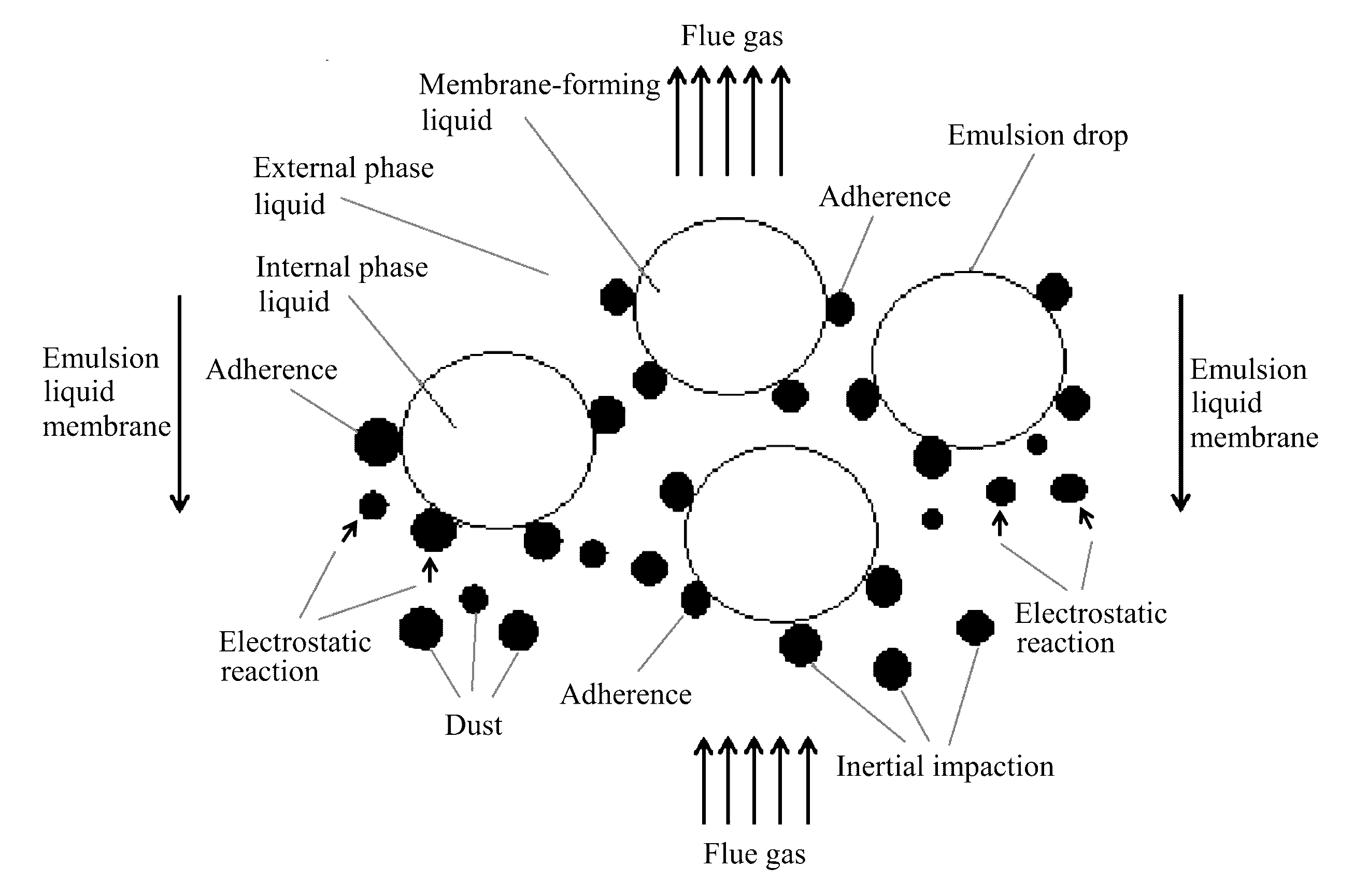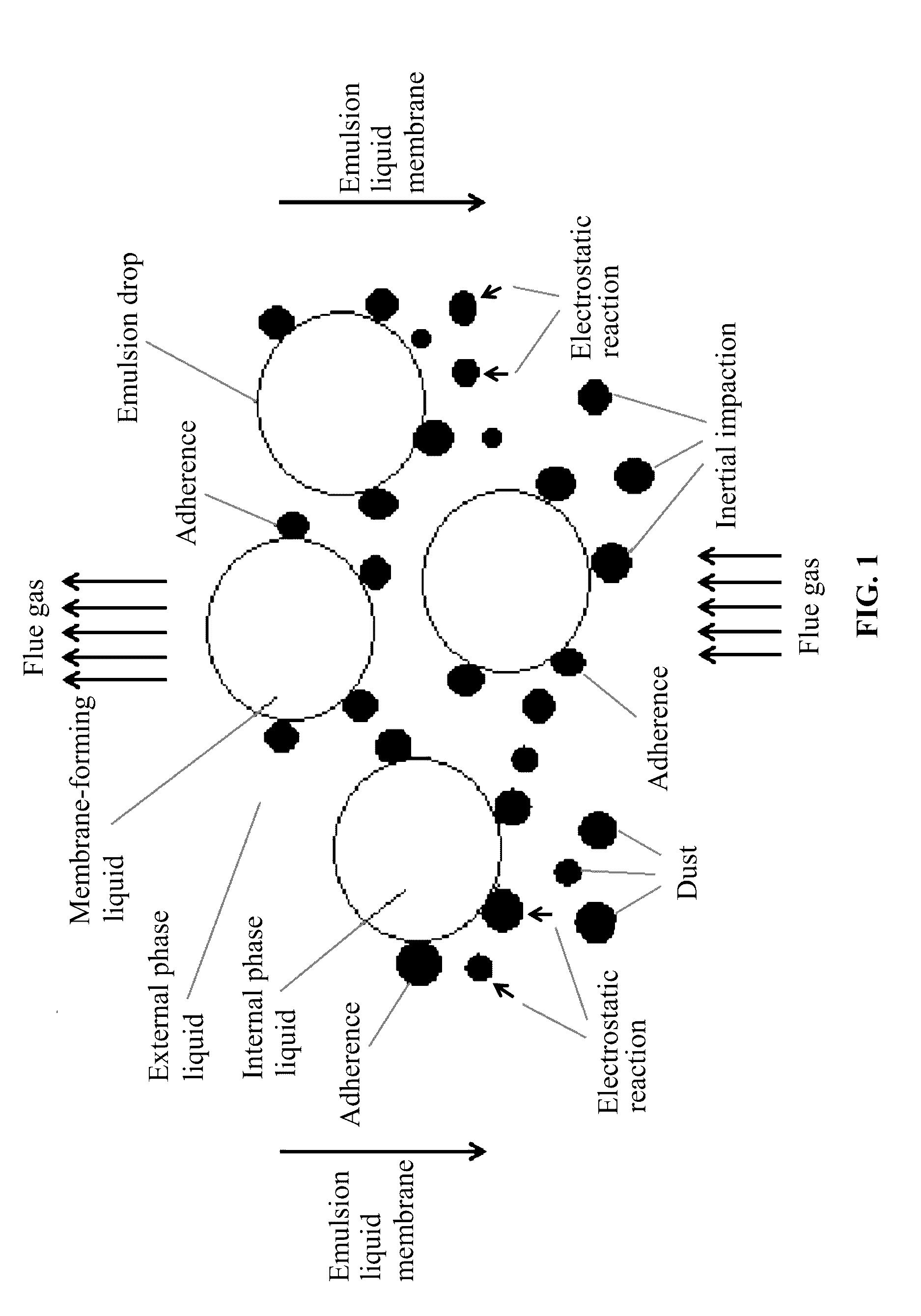Method for removing dust from flue gas using emulsion liquid membrane
a technology of emulsion liquid and flue gas, which is applied in the direction of dispersed particle separation, feed/displacement of settling tanks, separation processes, etc., can solve the problems of large amount of water consumption and ineffective removal of fine dust, and achieve the effect of convenient discharg
- Summary
- Abstract
- Description
- Claims
- Application Information
AI Technical Summary
Benefits of technology
Problems solved by technology
Method used
Image
Examples
example 1
[0042]1. Preparation of water-in-oil emulsion: a diesel oil as a membrane solvent and bis-succinimide as a surfactant were mixed according to a volume ratio of the membrane solvent to the surfactant of 97:3 to fully dissolve the surfactant into the membrane solvent and to yield a membrane-forming liquid. Water of an equivalent volume as an internal phase liquid was gradually added to the membrane-forming liquid while stirring at a rotational speed of 3000 rpm. The stirring was continued for 10 min after the addition of the internal phase liquid so as to yield a water-in-oil emulsion.
[0043]2. Dust removal from flue gas: the water-in-oil emulsion was mixed with water according to a volume ratio of the emulsion to water of 1:5 to prepare 1000 mL of an emulsion liquid membrane. The emulsion liquid membrane was allowed to contact with a flue gas having a dust content of 200 mg / m3 and a flow rate of 2 L / min while stirring at a rotational speed of between 250 and 300 rpm for removing dust ...
example 2
[0046]1. Preparation of water-in-oil emulsion: a diesel oil as a membrane solvent and sorbitan fatty acid ester as a surfactant were mixed according to a volume ratio of the membrane solvent to the surfactant of 96:4 to fully dissolve the surfactant into the membrane solvent and to yield a membrane-forming liquid. A saturated limewater as an internal phase liquid was gradually added to the membrane-forming liquid with a volume ratio of the membrane-forming liquid to the internal phase liquid of 1:0.5 while stirring at a rotational speed of 7000 rpm. The stirring was continued for 8 min after the addition of the internal phase liquid so as to yield a water-in-oil emulsion.
[0047]2. Dust removal from flue gas: the water-in-oil emulsion was mixed with water according to a volume ratio of the emulsion to water of 1:4 to prepare an emulsion liquid membrane. The emulsion liquid membrane was sprayed at a speed of 800 mL / min to contact with the flue gas having a dust content of 180 mg / m3 and...
example 3
[0050]1. Preparation of water-in-oil emulsion: a kerosene as a membrane solvent and succinimide as a surfactant were mixed according to a volume ratio of the membrane solvent to the surfactant of 95:5 to fully dissolve the surfactant into the membrane solvent and to yield a membrane-forming liquid. A saturated brine water as an internal phase liquid was gradually added to the membrane-forming liquid while stirring with a volume ratio of the membrane-forming liquid to the internal phase liquid of 1:1.5 at a rotational speed of 4800 rpm. The stirring was continued for 10 min after the addition of the internal phase liquid so as to yield a water-in-oil emulsion.
[0051]2. Dust removal from flue gas: the water-in-oil emulsion was mixed with brine water according to a volume ratio of the emulsion to the brine water of 1:3 to prepare 1000 mL of an emulsion liquid membrane. The emulsion liquid membrane was allowed to contact with a flue gas having a dust content of 200 mg / m3 and a flow rate ...
PUM
| Property | Measurement | Unit |
|---|---|---|
| flow rate | aaaaa | aaaaa |
| flow rate | aaaaa | aaaaa |
| rotational speed | aaaaa | aaaaa |
Abstract
Description
Claims
Application Information
 Login to View More
Login to View More - R&D
- Intellectual Property
- Life Sciences
- Materials
- Tech Scout
- Unparalleled Data Quality
- Higher Quality Content
- 60% Fewer Hallucinations
Browse by: Latest US Patents, China's latest patents, Technical Efficacy Thesaurus, Application Domain, Technology Topic, Popular Technical Reports.
© 2025 PatSnap. All rights reserved.Legal|Privacy policy|Modern Slavery Act Transparency Statement|Sitemap|About US| Contact US: help@patsnap.com



